Screens with bright displays and high resolution make using the device more appealing, whether you’re watching content, texting, or editing, every single detail pops.
While the focus has always been on enhancing image quality with features like retina displays in monitors such as the Studio Display, Apple is now looking into new technologies that go beyond visual displays.
Forget the conventional 170-degree field of view which could be LCD or OLED; Apple is on a mission to redefine privacy in displays. Recent patents suggest two distinct approaches the tech giant is exploring.
The first patent, aptly named “Privacy films for curved displays,” introduces a unique covering layer that acts like a polarizing film. Positioned directly on the screen, this layer ensures that users experience the full brilliance and retina-quality display when seated in the optimal position.
However, those attempting a sideways glance will encounter either a blank screen or, more likely, a distorted image. While this method doesn’t prevent someone from peeking over your shoulder, it’s a significant step towards personalized privacy.
In the second patent, “Displays with adjustable angles of view,” Apple takes a more precise approach by proposing an electrically controllable filter integrated into the display. This filter allows users to manipulate the polarization of the screen, altering the viewing angle at will.
The display incorporates a series of substrate layers, including an additional layer of liquid crystal with a color filter. This unique setup lets users restrict certain colors to their display, providing an added layer of privacy.
While the concept of hiding specific colors might seem less practical than concealing the entire screen, it harks back to the era of classified reports on colored pages. Apple’s exploration of these privacy-centric display technologies showcases the company’s commitment to pushing boundaries and reimagining how screens display information.
Apple’s commitment to transforming how screens display information is intriguing. For example, the upcoming Apple Vision Pro could feature a display that renders the screen blank to everyone except the authorized owner, kind of what we have with the Face ID, in which the notification details are only visible once it recognizes the owner of the device.





